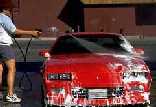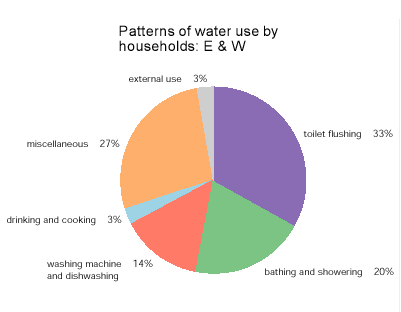Greywater Recycling Systems |
| Greywater is defined as the waste water produced from baths, showers, clothes washers, and wash-hand basins. The wastewater generated by toilets is called blackwater. Wastewater from kitchen sinks and dish-washers is often considered to be blackwater aswell, due to the higher organic content. As its name connotes, greywater is of lesser quality than potable water, but of higher quality than black water. |
 In Scotland and in many other parts of Europe, the population is spoilt in
terms of water usage. We have always had a plentiful supply of clean potable
water at our disposal. To many the idea of saving water in a country like
Scotland seems almost nonsensical.
In Scotland and in many other parts of Europe, the population is spoilt in
terms of water usage. We have always had a plentiful supply of clean potable
water at our disposal. To many the idea of saving water in a country like
Scotland seems almost nonsensical.| The water that we use to water the garden, the water we use to wash our
clothes, and the water that we use to fill toilet cisterns, is all of the same quality as
the water that we take from a tap and drink.
This need not be the case; in fact
the waste water from our clothes washing machines is actually more nutritious for
plants than ordinary water. The most obvious advantage of recycling domestic greywater is that it replaces potable water use. Greywater use also offers potential financial advantages to regional sewage treatment facilities. Their capital and operational expenditures may decrease because greywater use diminishes sewer flows, thereby lessening the need to expand such facilities. In recent times greywater usage has been flourising in parts of Australia and the semi-arid southern states of the US, where water can be scarce for many months of the year. In this part of the world, due to the weather and our infrastructure, there has been little drive to be conservative with our water use. The technology that is needed is very simple, and most systems are based on standard autonomous water treatment systems that are widely available. |
 |
|
 |
||
 |
 |
| Patterns of household water use1 |
| The water consumption in the UK on average is about 100 to 150
litres/person/day1,
with the large majority of this usage taking place in the domestic environment.
The patterns of use are described in the above chart, and as can be observed,
toilet flushing accounts for about a third of our daily water consumption. The water
that is used to fill these cisterns is of an acceptable potable quality.
This is not necessary. |
|
The system we are recommending for the Oatlands development is a simple Greyater
system with a Rainwater Harvesting system included. We recommend that
the treated greywater be used to fill toilet cisterns throughout the development. Discharge pipes from roofs, washing machines and other greywater sources are carefully annotated, with a two-way discharge system at ground level. One of these goes to the central discharge main, and the other to surface/sub-surface collection tanks, or a reed-bed treatment system. These tanks/beds could cater for a single block of dwellings, or a number of blocks, depending on capacity and design. |
 |
| Once the water is treated, it is pumped to a storage tank at
roof level, which in turn is used to fill the toilet cisterns
throughout the dwellings. As the system caters for many dwellings,
the time spent by the water in the system could be quite short (less than 24hours),
and would be very acceptable for treated greywater.
A surplus in supply from the sources could just be diverted to the usual drain, and a deficiency in supply could be augmented from the mains water supply. Both of these events would have taken place in the normal running of the dwellings. |
External Reference Links:
Water demand and patterns of usage.
Information on Greywater treatment and reuse systems.
Greywater kits for individual homes.
Environmental solutions company.
Sample issue of "e.water weekly".
![]() Return to main Proposals page
Return to main Proposals page